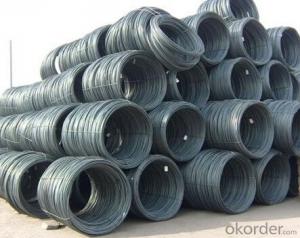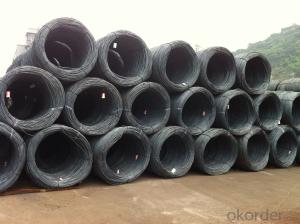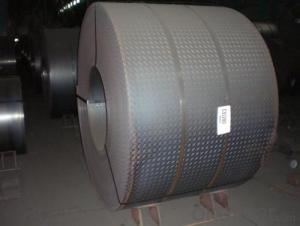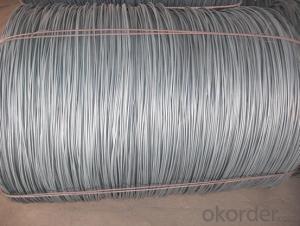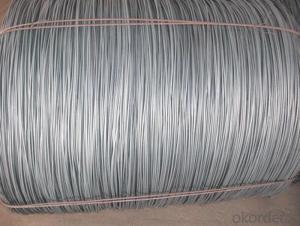Hot Rolled Wire Rod for Q195/235, SAE1006-1018B
- Loading Port:
- Tianjin
- Payment Terms:
- TT OR LC
- Min Order Qty:
- 500 m.t.
- Supply Capability:
- 10000 m.t./month
OKorder Service Pledge
OKorder Financial Service
You Might Also Like
1.Structure of Hot Rolled Wire Rod Description
After hot-rolled the products shaped into coil and delivery as finished product, including round, square, rectangular, hexagonal and so on. Since most of the products are round, it is generally called wire rod. Carbon steel wire rod is widely used in construction and manufacturing. Carbon steel wire rod is mainly used for reinforcement of reinforced concrete and welded structure or reprocessed (roberts , nail, etc.) materials, especially used to produce wire drawing, welding electrode, nails, spring, electronic, precise machinery parts and so on.
2.Main Features of the Aluminum Alloy Wheel Hub
high quanlity
easy to delivery
extensive use
3.Specifications of Hot Rolled Wire Rod
Steel Grade: Q195/235, SAE1006-1018B Standard: ASTM, GB
Diameter: 5.5mm, 6.5mm, 7mm,8mm,9mm,10mm,12mm,14mm
Type: in coil, coil weight around 2MT Alloy or Not: Alloy
Technique: Hot Rolled
Place of Origin: China Mainland
Surface: round, no twisted, light and smooth
Chemical Composition: (Please kindly find our chemistry of our material based on Q195、Q235A and Q235B as below for your information)
Trademark | Rank | Chemical composition (quality score) % | ||||||
C | Si | Mn | S | P | ||||
| ≤ |
| ≤ | ≤ | ||||
Q195 |
| 0.06-0.12 | 0.30 | 0.25 | 0.050 | 0.045 | ||
Q235 | A | 0.14-0.22 | 0.30 | 0.30-0.65 | 0.050 | 0.045 | ||
Q235 | B | 0.12-0.20 | 0.30 | 0.30-0.70 | 0.045 | 0.045 | ||
4.Packaging & Delivery of Hot Rolled Wire Rod
Packaging Detail: products are packed in coil, each coil weight around 2 MT, and then shipped by container or bulk vessel
Delivery Detail: within 45 days after received deposit or LC.
Label: to be specified by customer, generally, each bundle has 1-2 labels
Trade terms: FOB, CFR, CIF
5.FAQ
We have organized several common questions for our clients,may help you sincerely:
①How about your company?
A world class manufacturer & supplier of castings forging in carbon steel and alloy steel,is one of the large-scale professional investment casting production bases in China,consisting of both casting foundry forging and machining factory. Annually more than 8000 tons Precision casting and forging parts are exported to markets in Europe,America and Japan. OEM casting and forging service available according to customer’s requirements.
②How to guarantee the quality of the products?
We have established the international advanced quality management system,every link from raw material to final product we have strict quality test;We resolutely put an end to unqualified products flowing into the market. At the same time, we will provide necessary follow-up service assurance.
③How long can we receive the product after purchase?
In the purchase of product within three working days, We will arrange the factory delivery as soon as possible. The pecific time of receiving is related to the state and position of customers.Commonly 7 to 10 working days can be served.
- Q:What are the standard surface roughness requirements for steel wire rod?
- The standard surface roughness requirements for steel wire rod typically vary depending on the specific industry and application. However, in general, the surface roughness for steel wire rod is usually specified to be within a certain range, such as Ra 0.8-1.6 µm (micrometers) or Ra 32-63 µin (microinches). These requirements ensure that the surface of the wire rod is smooth enough to meet the desired performance and functionality while also allowing for efficient processing and handling.
- Q:How is steel wire rod used in the manufacturing of wire for springs in mattresses?
- Steel wire rod is used in the manufacturing of wire for springs in mattresses as it serves as the primary material for creating the springs. The wire rod is first drawn and stretched to the desired thickness and then coiled into springs of various sizes and shapes. These springs are then interconnected to form the core structure of the mattress, providing support and resilience. The high tensile strength and durability of steel wire rod make it an ideal choice for ensuring the longevity and comfort of the mattress.
- Q:How is steel wire rod used in the manufacturing of piano strings?
- Steel wire rod is used in the manufacturing of piano strings as it provides the necessary strength and durability required for producing high-quality sound. The wire rod is first drawn into thin and uniform strands, which are then wound tightly to form the piano strings. This process ensures that the strings have the desired tension and can produce the desired pitch when struck by the piano hammers.
- Q:How is the dimensional accuracy of steel wire rod measured?
- The dimensional accuracy of steel wire rod is typically measured using various techniques and tools to ensure that the dimensions of the rod meet the required specifications. Some commonly used methods to measure the dimensional accuracy of steel wire rod include: 1. Calipers: Calipers are used to measure the diameter of the steel wire rod. They can be either manual or digital, and they provide accurate readings by tightly gripping the rod and measuring its diameter. 2. Micrometers: Micrometers are precise measuring tools used to measure the diameter of the steel wire rod. They provide highly accurate readings by using a calibrated screw mechanism to measure the dimensions. 3. Optical measurement systems: Optical measurement systems use advanced technology, such as lasers or cameras, to measure the dimensions of the steel wire rod. These systems provide accurate and quick measurements by capturing multiple data points and analyzing them to determine the dimensional accuracy. 4. Ultrasonic measurement: Ultrasonic measurement techniques involve emitting ultrasonic waves into the steel wire rod and analyzing the reflected waves to determine its dimensions. This method is especially useful for measuring the thickness and cross-sectional dimensions of the rod. 5. Automated measurement systems: Automated measurement systems utilize specialized equipment and software to measure the dimensional accuracy of steel wire rods. These systems can provide accurate and repeatable measurements by employing robotics, sensors, and image processing algorithms. It is important to note that the specific measurement technique used may vary depending on the required dimensions, tolerances, and the capabilities of the manufacturer or testing facility.
- Q:How is steel wire rod used in the manufacturing of wire for conveyor belts?
- Steel wire rod is the primary raw material used in the manufacturing of wire for conveyor belts. It is drawn into smaller diameters, often through a die, to form individual wires. These wires are then twisted or woven together to create the wire mesh that forms the core structure of the conveyor belt. The strength and durability of steel wire rod make it ideal for withstanding the high tension and heavy loads that conveyor belts often encounter in various industries.
- Q:How are steel wire rods used in the production of electrical cables for power transmission?
- Steel wire rods are indispensable in the production of electrical cables for power transmission. These rods are utilized to give the cables strength and support, ensuring their ability to endure the high voltage and mechanical strain associated with transmitting electricity over long distances. Typically crafted from high-quality carbon or alloy steel, the steel wire rods possess exceptional tensile strength and durability. These qualities make them suitable for withstanding the heavy loads and tension experienced by electrical cables during power transmission. Throughout the manufacturing process, the steel wire rods undergo wire drawing, which involves pulling them through a series of dies to reduce their diameter and increase their length. This procedure refines the steel's mechanical properties, enhances its uniformity, and allows for precise control over the wire's dimensions, guaranteeing compliance with the required specifications for power transmission cables. Once the wire rods are drawn to the desired size, they undergo further processing to create the individual strands that comprise the electrical cables. These strands are formed by twisting multiple steel wire rods together, resulting in a resilient and pliable core capable of carrying the electrical current. Following the formation of the strands, they are typically coated with insulation material such as PVC or XLPE. This insulation layer safeguards the steel wire rods from corrosion and provides electrical insulation, preventing any leakage or short-circuits during power transmission. In conclusion, steel wire rods play a vital role in the production of electrical cables for power transmission by providing the necessary strength and support to withstand the mechanical strain and high voltage involved in transmitting electricity over long distances. By incorporating steel wire rods into the cables, manufacturers can ensure the reliability and efficiency of power transmission systems.
- Q:What are the potential risks and hazards associated with handling steel wire rod?
- The potential risks and hazards associated with handling steel wire rod include the risk of cuts or puncture wounds from sharp edges or protruding wire ends, the possibility of strain or musculoskeletal injuries from lifting or carrying heavy wire rods, and the potential for eye injuries from flying debris or sparks during cutting or welding processes. Additionally, there may be a risk of exposure to hazardous substances, such as oils or coatings used to protect the wire rod, which could cause skin irritation or respiratory issues if proper protective measures are not taken.
- Q:What are the standard impact strength requirements for steel wire rod?
- The impact strength requirements of steel wire rod can differ based on the specific application and industry standards. However, in general, steel wire rod needs to have good impact strength properties to ensure durability and resistance against breakage in dynamic loading situations. Various international standards organizations like ASTM International, ISO, and national standards bodies establish the impact strength requirements. These standards offer guidelines for determining the impact strength of steel wire rod through standardized testing methods. To fulfill the standard impact strength requirements, steel wire rod is often subjected to impact tests such as Charpy or Izod tests. These tests involve striking a notched sample of the wire rod with a pendulum hammer and measuring the energy absorbed during fracture. The results provide an indication of the material's ability to endure sudden shock or impact. The specific impact strength requirements for steel wire rod can differ based on factors such as the intended application, industry regulations, and customer specifications. For instance, wire rod used in construction may have different impact strength requirements compared to wire rod used in automotive manufacturing. In summary, the impact strength requirements for steel wire rod are determined by international and national standards organizations and can vary depending on the application. Complying with these requirements ensures that the wire rod possesses the necessary strength and resilience to withstand impact and dynamic loading conditions.
- Q:What are the common alloying elements added to steel wire rod?
- The common alloying elements added to steel wire rod are primarily manganese, silicon, and carbon. Manganese is often added to improve the strength and hardness of the steel, as well as enhance its resistance to wear and tear. Silicon is added to improve the steel's ability to resist oxidation and enhance its overall strength. Carbon is a crucial element that determines the steel's hardness and strength, and it is typically added in varying amounts to achieve the desired properties. Additionally, other alloying elements such as chromium, nickel, and molybdenum may also be added in specific applications to further enhance the steel's properties, such as corrosion resistance or high-temperature strength.
- Q:How is steel wire rod recycled at the end of its lifecycle?
- Steel wire rod is typically recycled at the end of its lifecycle through a process called steel scrap recycling. This involves collecting the steel wire rod scrap from various sources such as manufacturing waste, construction sites, and end-of-life products. The collected scrap is then sorted and cleaned to remove any contaminants. Next, the scrap is melted down in electric arc furnaces or basic oxygen furnaces to produce molten steel. Subsequently, the molten steel is cast into new wire rod shapes through processes like continuous casting or hot rolling. Finally, the newly produced wire rod is used in various industries to manufacture different products, ensuring a sustainable and efficient utilization of steel resources.
1. Manufacturer Overview |
|
|---|---|
| Location | |
| Year Established | |
| Annual Output Value | |
| Main Markets | |
| Company Certifications | |
2. Manufacturer Certificates |
|
|---|---|
| a) Certification Name | |
| Range | |
| Reference | |
| Validity Period | |
3. Manufacturer Capability |
|
|---|---|
| a)Trade Capacity | |
| Nearest Port | |
| Export Percentage | |
| No.of Employees in Trade Department | |
| Language Spoken: | |
| b)Factory Information | |
| Factory Size: | |
| No. of Production Lines | |
| Contract Manufacturing | |
| Product Price Range | |
Send your message to us
Hot Rolled Wire Rod for Q195/235, SAE1006-1018B
- Loading Port:
- Tianjin
- Payment Terms:
- TT OR LC
- Min Order Qty:
- 500 m.t.
- Supply Capability:
- 10000 m.t./month
OKorder Service Pledge
OKorder Financial Service
Similar products
New products
Hot products
Hot Searches
Related keywords
